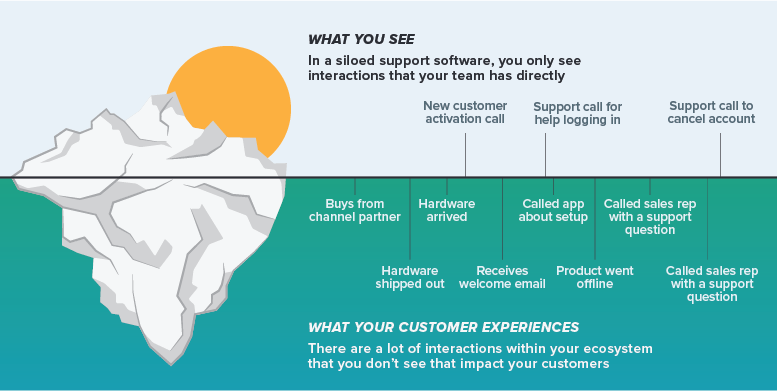Who’s responsible for creating amazing customer experiences?
Marketing and sales? Or is it the support agents who interact directly with customers when they have a question or concern?
Though it can seem like it’s up to frontline agents to provide seamless, consistent service and support, the best customer experiences are orchestrated much, much further up the food chain.
After all, amazing customer experiences aren’t something that just happens.
Great CX requires coordination and cooperation between all team members and departments. More importantly, for best results, company leaders need to own customer experience management.
By assuming an active, vocal stance on customer experience management, executives and directors can inspire team members to adopt customer-first practices at every touchpoint on every channel.
What is Customer Experience Management?
Customer experience management is the process of engineering customer experiences and interactions that inspire long-term loyalty, increase retention, and build brand advocates. It’s about taking control of the customer experience by thinking about each interaction from the customer’s perspective and then taking deliberate action to turn those interactions into a cohesive customer journey to improve the overall experience.
Better CX Management Is Great for Business
Better customers experiences make for happier customers – and happy customers are great for your bottom line. Satisfied customers can become major revenue-drivers in the form of:
- Brand advocacy and new customer referrals.
- Long-term loyalty that lowers your rate of churn along with your customer acquisition cost.
- Higher average spend-per-customer (and greater customer lifetime value), since existing customers tend to spend more than new customers.
Overcoming Challenges: What’s Standing in the Way of Amazing CX?
If customer experience management can lead to such amazing results, why aren’t businesses putting more resources into CX?
One of the challenges associated with customer experience management is delivering cross-channel consistency. The more channels involved, the harder it becomes to maintain a perfectly streamlined experience across the board.
In order to revamp a fragmented CX, organizations need to start thinking about the entire customer journey holistically, rather than as individual touchpoints.
This includes dedicating resources towards initiatives, tools, and training that prioritize CX. It also requires buy-in from the entire team, refined support processes, and a defined set of metrics for measuring results.
The best way to overcome these challenges? Driving change from the top-down. That means CEOs and directors need to get fully on-board with repositioning CX as a central aspect of the company’s mission, policies, and strategies.
Prioritizing Customer Experiences from the Top-Down

While most CEOs realize that CX influences their success – with 97% of executives surveyed by Oracle recognizing that providing great customer experiences are critical to their company’s success – a smaller portion take the initiative to champion and fund practices and policies that support CX improvements.
According to research from The Economist Intelligence Unit, about one-third (34%) of companies don’t bother measuring the success of their CX initiatives.
Furthermore, there’s widespread confusion over who is actually responsible for CX management. Although 72% of CEOs claim to own the process, only 27% of other C-level executives agree that the CEO is the leading force in CX management.
Realizing the need for better customer experiences is a great first step, but it’s just the beginning of what CEOs and directors need to do to make it a reality. If you really want to champion CX, you need to put your money where your mouth is.
Why Executives Need to Become Customer Experience Champions
Even though they don’t interact with customers directly on a frequent basis, executives’ and directors’ ideas about customer service and expectations shape how the rest of the business approaches CX.
Here’s why executives need to champion customer experience management:
- To Set the Standard: The best way to communicate that CX is a priority for everyone on the team is for executives and directors to lead by example. This means embracing CX management as a pillar of their organization.
- To Influence Policy Updates: In order for customer experience management to saturate your entire organization, it needs to start from the top and trickle down into every department and customer interaction. Executives have the power to inject CX management into your business’ core DNA by building it into company policies and employee training.
- To Allocate Resources to CX: Company leadership has the power to allocate appropriate resources to improve, implement, and train team members on CX management strategies. Rather than expecting the support team or sales reps to vocalize their need for tools that improve CX, executives need to recognize the importance of providing access to the necessary technology and training.
- To Increase ROI: A company’s ROI on CX initiatives increases when the CEO is leading the cause. In fact, of businesses where CEO owns the CX process, 64% reported greater profitability than their competition. Another 59% believe their revenue growth is directly linked to the company’s investment of time and resources for implementing better CX.
To experience the full extent of these benefits and more, CEOs need to position themselves as customer experience champions. This means prioritizing and advocating for better customer experiences, as well as taking an active role in defining policies, strategies, and procedures related to CX.
Developing an Effective CX Management Strategy
Let’s take a look at what goes into creating a CX strategy and the steps you can follow to develop your own.
1. Get to Know Your Customers on a Deeper Level
The better you understand your customers, the better you can cater to their needs and meet (or exceed) their expectations. This begins with identifying who your customers are and what they care about.
What are their goals, priorities, and pain points? What are they hoping to get from your product or service? Use this knowledge to create customer profiles that will inform the rest of your CX strategy.
2. Map Out the Customer Journey from Their Perspective

Effective customer experience management requires looking at the entire customer journey holistically. That is, you need to consider the whole picture from start to finish – not just the interactions that involve your business.
For instance, what is the customer doing in between each interaction with your business? What other factors are contributing to their experience? Are there other providers involved? Is there shared knowledge between different providers or is the customer experience ultimately restricted to silos?
3. Identify Goals, Needs, and Challenges at Each Stage
The next step is to figure out the customer’s goals, challenges, and expectations at each step of the customer journey. Remember to look at both pre-purchase and post-purchase interactions.
Understanding how the customer feels at various touch points makes it possible to personalize and optimize the experience. This allows you to deliver as much value as possible in the form of proactive support, ease-of-access to information, intuitive design, and a seamless experience overall.
4. Design a Framework to Address Customer Needs at Every Stage
To put your strategy into action, create a framework for determining what tools and information a customer needs access to at every stage of their journey. Invest in omnichannel, proactive support solutions that address the customer journey holistically and provide seamless experiences across all channels and touchpoints.You need to empower frontline agents to provide the type of support that aligns with your CX goals. Provide the technology, resources, and access to shared knowledge they need to excel in their roles.
5. Define and Track Metrics to Measure Your Success
The rules of CX are always changing, which means your process can always be improved. However, in order to improve, you need to track your progress with established metrics.Keep tabs on customer service metrics that reveal how effectively your team is implementing your CX strategy and how these changes are impacting customer satisfaction and loyalty. For example, track your net promoter score, customer effort score, and any other help desk metrics linked to your strategy.
Become a Customer Experience Champion
Every aspect of the customer journey influences how they feel about your brand, business, and service or product. By making CX management a priority, you can win over new customers, inspire long-term loyalty, and build a brand synonymous with amazing customer experiences.Want more content like this? Sign up to receive monthly updates and learn more about creating amazing customer experiences through technology, support, and strategy.[gravityform id="6" title="true" description="true"]





